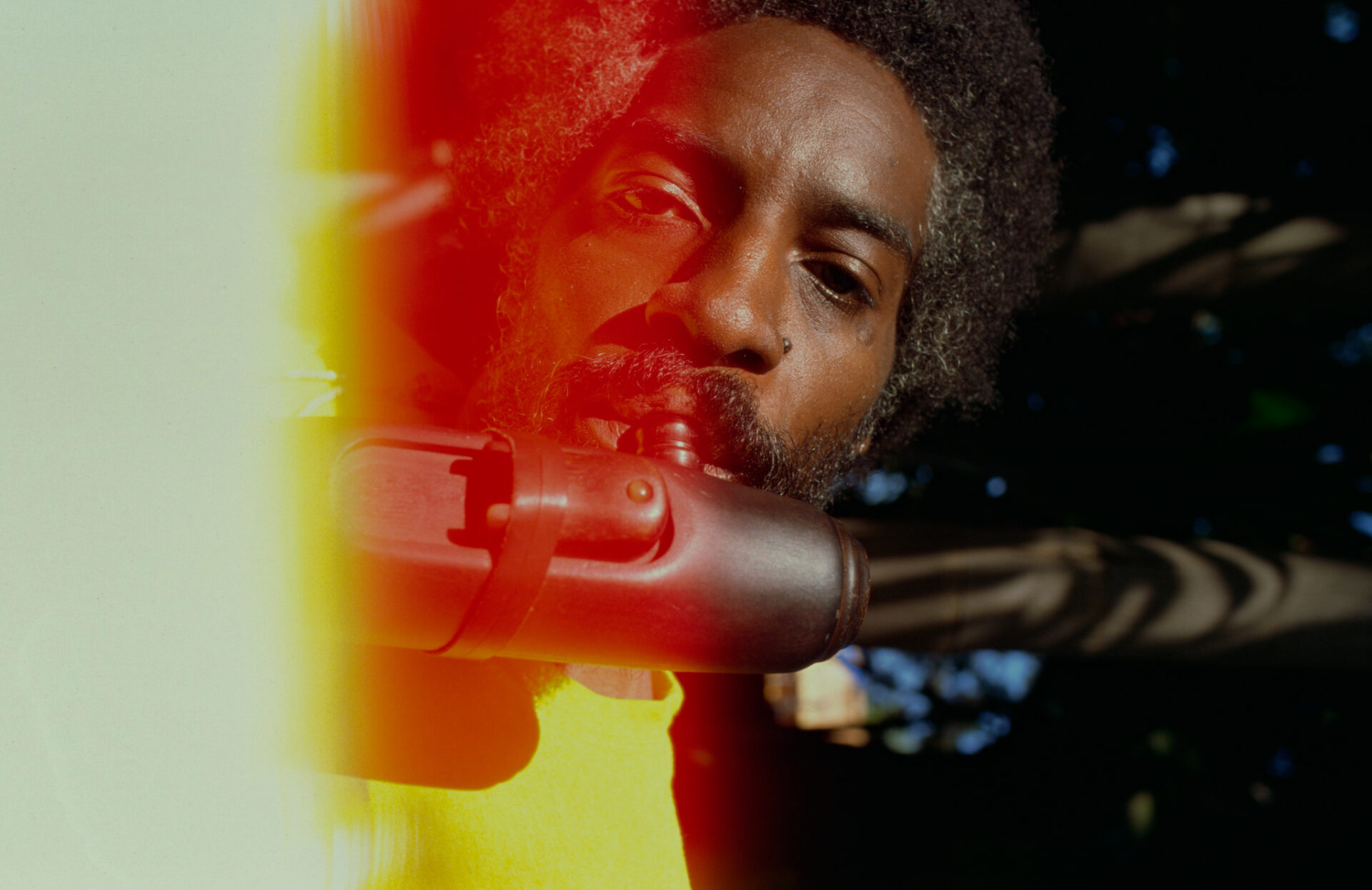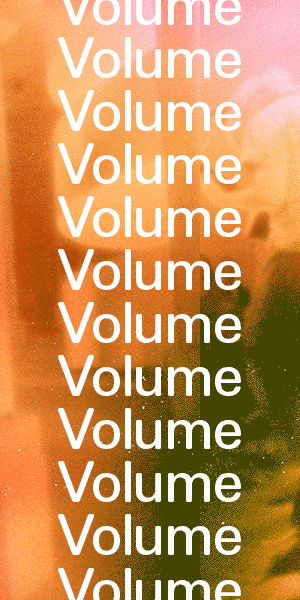For Volume, Jonathan Wilson Expands on the Boundaries of What an Artist Actually Is

“Music and art have been intertwining for the last 50 or 60 years,” says AGNSW music curator Jonathan Wilson as he exits the Tank to discuss the Volume program. Returning this week with four headline artists—André 3000, Kim Gordon, Genesis Owusu, and Tkay Maidza—the eleven-day program will showcase a range of work, from avant-garde jazz to trap-beat-driven noise, post-punk R&B, EDM, and melancholia. Here, Jonathan Wilson shares his insights on the artists who are effectively merging these disciplines, how the AGNSW audience will engage with their performances, and why the gallery is focusing on the fusion of the visual artist and the musician.
Jonathan Wilson I’m just coming out of the wonderful oil tank. We’ve been installing a piece for Volume. I’m very excited about it.
Rachel Weinberg Can you describe what it looks like?
JW Jonathan Zawada and Flume have created what we’re calling a deconstructed EDM festival. The installation includes about sixty different pieces that all run in a sequence with lasers, lighting, projections and music.
RW The Volume series is presented within the Art Gallery of New South Wales. What do you consider the strengths of showcasing music in an art gallery space, and why do you think an auditory medium can exist and thrive in what is traditionally a very visual environment?
JW Music and art have been fusing together for the last 50 or 60 years. I don’t think that every musician is classified as an artist. Some are great players, some are great performers, and some are great writers. In the same way, there are a lot of artists who are transitioning to dance and music, but not all of them can be classified as musicians. There are a few musicians that blur the lines and find a balance with their aesthetics, art, and sound. Part of my job is to bring those people into the gallery space and expand on the boundaries of what an artist actually is.
RW When did you first realise that a musician could be more than a musician?
JW I think really great music has always been synonymous with art. I’m thinking about the Velvet Underground, Lou Reid and the early artists who came through Andy Warhol’s factory. I studied fine art but started playing music when I was four years old, so I’ve always had this blurred idea of music as art.
RW Are there any specific artists you can think of that successfully blurred that line?
JW I love Mark Leckey. He won the Turner Prize a couple of years ago for his visual art. The work that he won the prize for was Fiorucci Made Me Hardcore, which was a film about the Northern Soul dance scene in the UK. What is so amazing is that he released that work as an album, which was brilliant as well.
RW You mentioned this briefly, but I want to go back and ask about your time studying fine art and playing in a band. What were you like then, and how did you get on the path you’re on now?
JW I’ve always been interested in new music and what’s at the forefront. I was always looking for something that I hadn’t heard. When I was studying in the 1990s, there was a very hard line between music and art. That is what pushed me. I never understood why those two things weren’t intrinsically linked, because the way I was thinking about visual art was the way I was thinking about music. I never really saw much of a difference between the two. But I ended up writing for magazines and writing about music that I found, which eventually dovetailed into running a record company. The label I ran was very specific and very interested in experimental sounds. I’ve carried that approach into the curatorial space that I am in now. I try to bring the best to the future.
RW Do you think that the audience, whether that be in Sydney or Australia, more widely, is attentive to that newness? Is that something they know they want, or is that something that you’re trying to show them that they need?
JW That’s a good question. In short, yes, for both parts. I think there’s an audience that wants this stuff, wants to be challenged and wants to come into art institutions that are full of ideas and exposed to newness. I also think that there are probably audiences that aren’t as interested. But I think if you come with an open mind and walk into any museum in the world with an open mind, surely there’s something in there that’s going to reframe and change your thinking. And that’s what I’m interested in—a space to explore ideas and concepts and change your perspective.
RW Is there something overseas or in another gallery that you saw that made you think that something like this would be possible at AGNSW?
JW Not necessarily. I’ve spent so much time watching live music and have witnessed that very transactional experience of paying for a ticket, going to the concert hall, sitting down, watching the show and then leaving. It was leaving me a little cold. I wanted to introduce a non-transactional music experience. An art space is the best place you can do that because it’s a fluid space where you can move through it. I’m seeing this happen more and more around the world. There are a lot of institutions pushing the boundaries of contemporary music in art spaces.
RW What are your thoughts on music festivals incorporating large-scale art installations into their outdoor venues and making them a key part of their offerings? Do you think this approach is effective, or do you believe that integrating music into gallery spaces is a better combination?
JW It always comes back to who the artist is and who has the ability to translate that conversation into a large space. I’m relying on my knowledge of music to bring the right artists into the gallery space to create something unique and bespoke. I saw a really great post last night from Genesis Owusu, who is adapting his entire show for the gallery. He came in, we had a meeting, he visited the space, and he threw all his ideas out the window because he wanted to be more responsive to his environment. Now it’s going to be a totally unique show, created specifically for the tank.
RW What else can we expect to see in the Volume series? Will all the artists be performing in the Tank? For those who haven’t been to the Tank before, can you describe it?
JW Yep, all of the live performances will be in our tank. The tank is a 1940s oil tank at the bottom of the new gallery, which is now called Naalabadu. The tank was built for the Second World War, decommissioned in the 1970s and decontaminated in the 1990s. Solange played in there last year, and she really worked with the sound in the space and created an entire new music piece of music to fill the space. Artists come in, create specifically for the space.
RW Looking ahead, what are your aspirations for the Volume series? I know you came in wanting to bring music into art and invite a more intentional listening experience. How do you see that evolving in the next few years?
JW One of my favourite parts of this programme is this installation with Jonathan Zawada and Flume. Jonathan Zawada is a visual artist, and he’s been creating visuals for years for some of the biggest artists in the world. He’s been working with Flume for nearly ten years, and the two of them have created this experiential installation. I really want to see the fusion of the visual artist and the musician. That’s where I see the programme evolving in the future.
RW What would your dream line-up be?
JW Mark Leckey. I’d be crazy if I didn’t say Thom Yorke. Those artists who are working across edges of music and art. There is also a crew of new artists that I’m interested in working with, ranging from more experimental ambient genres to more abrasive, heavy ones.
RW Do you find that originality is more important than relevance?
JW I think there are artists who are senior career artists who have massive followings and are potentially not being thought of anymore in a performative space. That’s what I love about this year’s line-up. We have Genesis Owusu opening and André 3000 closing. You have this younger artist who is really challenging what it is to make popular music, and you have one of his heroes playing who hasn’t made a record in 17 years. And that’s the beauty of the gallery as a space to play and perform. It’s not like a standard festival, where you have a hierarchy of headline artists. There’s no hierarchy here. They’re all playing. They’re all part of a programme. They’re all part of what Volume is. Everybody expects André 3000; he’s an outcast; he’s one of the greatest rappers of all time, but he sits outside of expectations by delivering a new jazz record that’s based around the flute. Then there is Kim Gordon, who is a senior career artist who is making the best music of her life. Her music is confronting, wild and really quite full on. I’m far more interested in people like Kim and Andre who sit on the edge of their medium.
Volume will be presented at the Art Gallery of NSW from Friday, July 5, to Sunday, July 21. Sign up for program announcements and news from the Art Gallery of New South Wales and learn more about the program here.
THY FRIENDSHIP makes us FRESH
By Rachel Weinberg
Hiro Kone’s Sonic Philosophy
By Annabel Blue
Captivating Contemporary Experiences : Melbourne Recital Centre's 2024 Program
By Amelia Szabo
Nastya Sipulina of oqbqbo on the electronic music scene in Copenhagen
By Annabel Blue
MUSIC, SEX AND HEARTBREAK
By Sophie Martin
Collective escapism
By Hugh Barton
